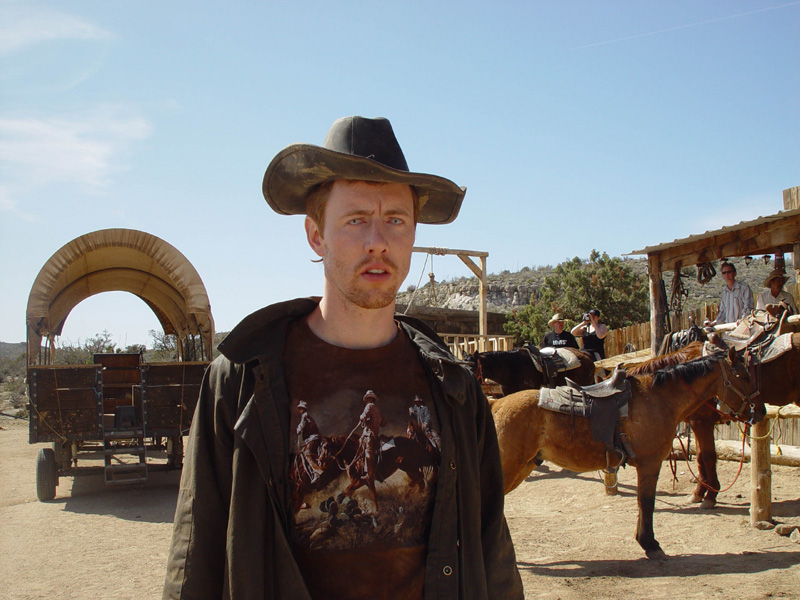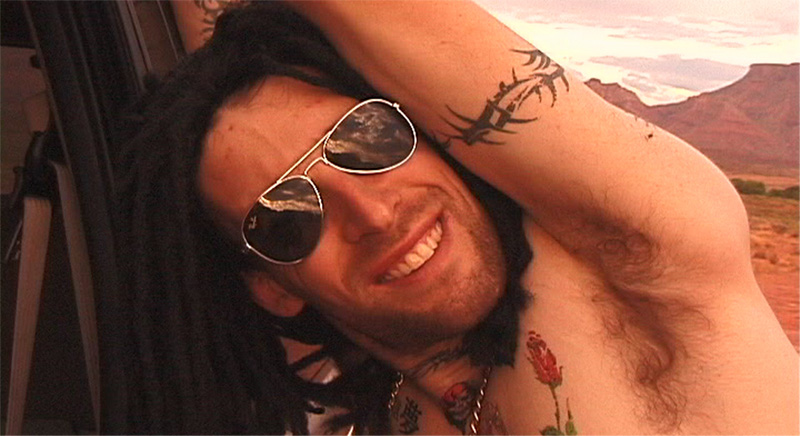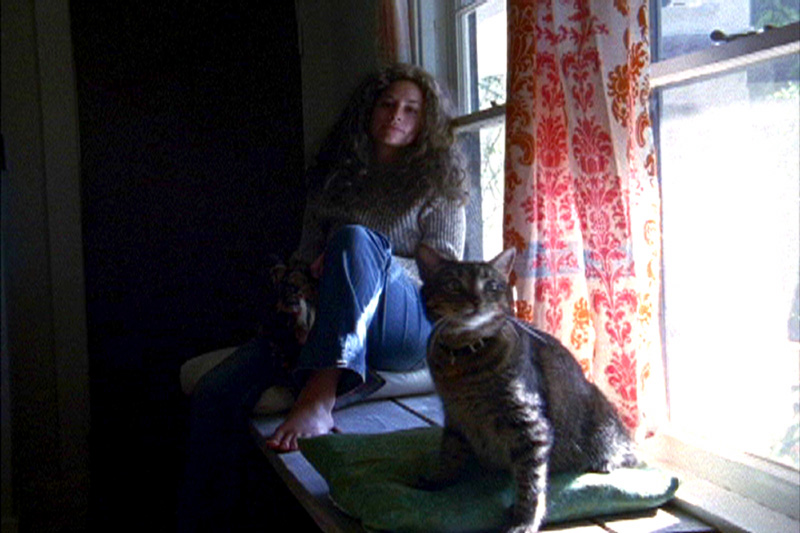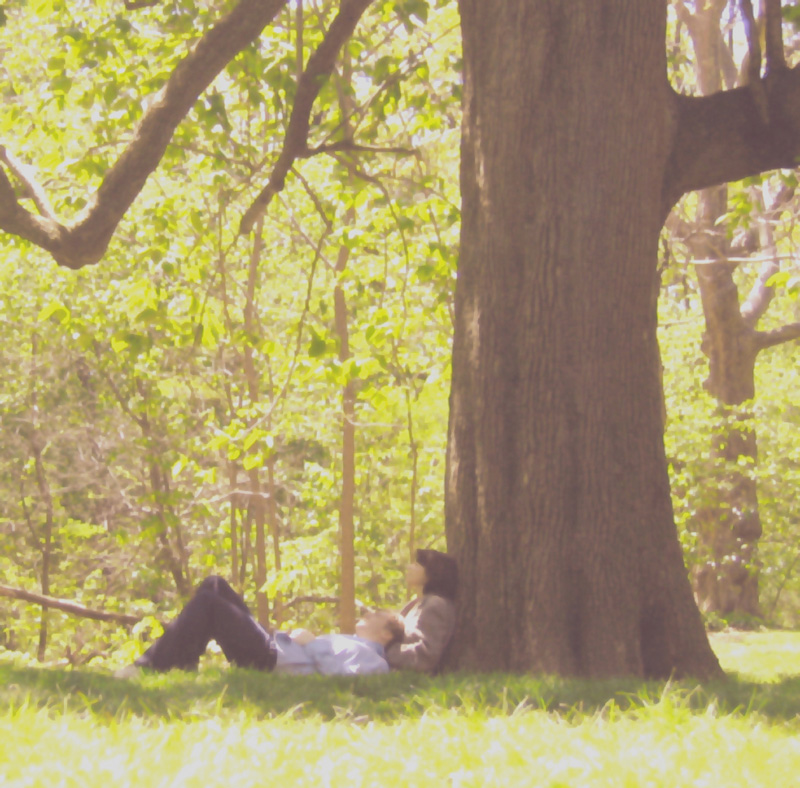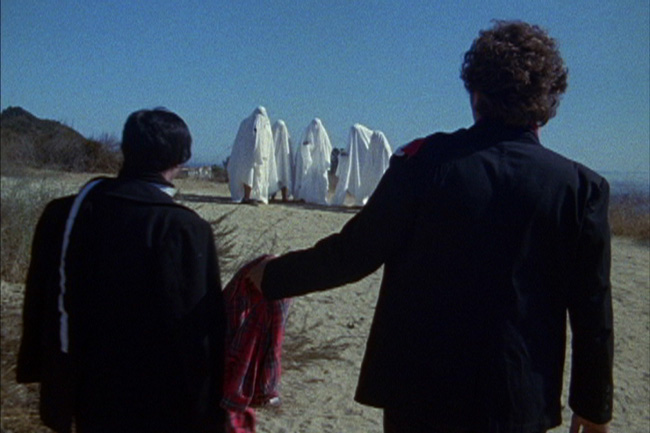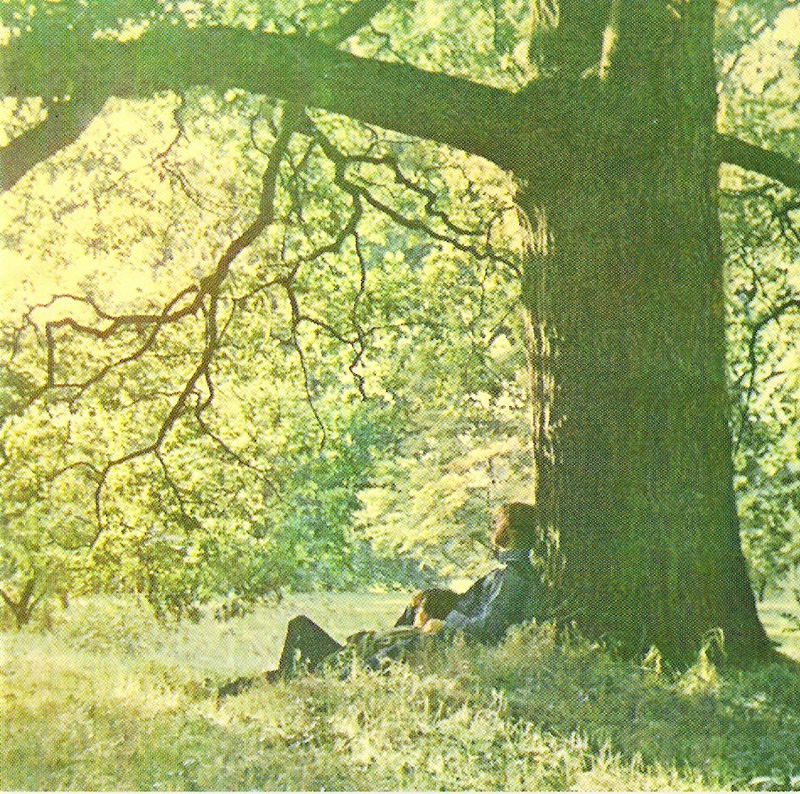Part of Fall 2007
“He’s a culture hopper / he’s traveled all around / trying to find the reason why he don’t fit in or out / he’s a culture hopper / he’s traveled for miles and miles / tryin’ out each culture just to see if he can make folks smile.” – Olaf Breuning, Home
Olaf Breuning, Goody-B. Wiseman and Phil Collins create new mythologies from studying and re-purposing the cultural detritus found around them. We watch and try to decipher the contemporary vernacular produced for us but inevitably get lost in the process.
Mixing pop-culture signifiers with elements of folk traditions, Breuning’s King (2000, 9 min. video), Group (2001, 10 min. video) and Home (2004, 32 min. dual-channel video) position him as a twenty-first-century globetrotter. Throughout the work, Breuning provides us with a tourist’s view of myths that have slipped from one social space to another with only the occasional glimpse of recognizable meaning: cavemen who have come ashore from Valhalla ride around in an RV; in MTV spring-break “reality” style, a skier spells the words “I EXIST” by puking champagne into the snow; artificial movie cowboys protect an artificial movie ranch.
Created to commemorate the 80th anniversary of TV, Collins’s He Who Laughs Last Laughs Longest (2006, 5 min. 35mm) is an exhilirating short document of a laughing contest in the UK staged by the artist, where competitors have to laugh as hard, loud and long as possible to win a wad of cash.
Finally, Wiseman’s sublime Superlovestarpower 2 (The Album Project) (2006, 12 min. video) is a trilogy of fantasized dramatizations of the events before, during and after the instants immortalized on three classic rock album covers: “Part nostalgia, part science fiction, [it] explores the margins of the known to discover what could have been” (Wiseman).
But we must not forget Roland Barthes’s warning in Mythologies: by trying to make sense of every element of these representational pile-ups – reality show atop music video atop advertisement atop documentary – we “constantly [run] the risk of causing the reality which [we purport] to protect, to disappear.”
Programme Notes:
The Sign Flashed Out Its Warning
Programme:
Goody-B. Wiseman, Superlovestarpower 2 (The Album Project), 2006, 12 min. 16mm/video
Olaf Breuning, King, 2000, 10 min. video
Group, 2001, 10 min. video
Home 1, 2004, 32 min. 2-screen video
Phil Collins, He Who Laughs Last Laughs Longest, 2006, 6 min. 35mm
“Everything begins to merge in a primordial stew of uprooted meaning.”
– Chris Chang on Olaf Breuning, Film Comment
This screening was inspired by a quote from curator Philippe Vergne about the young American artist Cameron Jamie’s exhibition at the Walker Art Center: “[His] work conflates investigative strategies, autobiography, mythologies, vernacular traditions, and urban folklore to examine contemporary life, our fascination with the outlandish, and our need for escapism – what one critic has identified as ‘backyard anthropology’ or what the artist calls ‘social theater.’” In Vergne’s list, we found a constellation of themes that seemed to describe a compelling trend in contemporary art practice. The title of this programme is a line of Simon and Garfunkel’s hit song “The Sounds of Silence” – featured in Goody-B. Wiseman’s phenomenal new work Superlovestarpower 2 &lrquo;” but inflected with the legacy of semiotics: here an abundance of signifiers of an increasingly globalized popular culture form the material and texture of these often funny but always perverse recent films and videos by American artists Goody-B. Wiseman and Olaf Breuning, and British artist Phil Collins. All three of these (relatively) young interdisciplinary artists are interested in how cultural artifacts and practices travel from one context to another, whether it be the increasing globalization of Western mass culture (reality shows, pop music, cultural stereotypes and archetypes) and the excesses of cultural tourism, or how fictions become so potent to those that devour them that they become in some way real.
“Breuning’s cast brings us into contact with nothing more than their own far-flung facades &lrquo;” to the garb they are costumed in, to the fact that they are nothing more than a front &lrquo;” in front of which communicability eventually stops short&lrquo;¦ Adorned in a jumble of signs pointing only to their abstraction, these beings are left stranded with no identifiable signifying order to latch onto.” – Carissa Rodrguez, Parkett
Deranged, childlike yet somehow endearing, the unnamed narrator of Breuning’s Home 1 – brilliantly played by one Brian Kerstetter, who may or may not be the artist himself – waxes distractedly about his globe-trotting around a world populated by the figures of film and TV, art and fashion: from hot tubbing at a ski resort to selling drugs to French teenage girls (only to see them preyed on by ghosts), to his games of dress-up as a zombie, a cowboy, a metalhead, a homeless man&lrquo;¦ and then there was that time that his posse drove out to the country and attacked an Amish lad, stripping him naked and forcing an E.T. mask over his head. In this two-screen projection, made during an actual year-long tour of the globe, the twin frames have an unsettling, dynamic relationship: On the right in black and white, the narrator reminisces about his aimless adventures as they play out on the other screen in colour. What gives the work its punch, however, is that his spastic present-day body contorts as if channeling and then splaying his memories onto the other screen, as if physically becoming a grotesque, psychologically unbalanced projector for his absurd travelogue right before our eyes. This fusing of the two forms of storytelling through the nexus of Kerstetter’s convulsive, ADD-addled body traps you irredeemably in his abrasively ignorant view of the world.
All of Breuning’s work has a trashy, vulgar and amateurish quality that highlights its own fakeries, unlike say the completely artificial Venice the narrator visits in the middle of Las Vegas, with its desperate verisimilitude. No matter how ridiculous or outlandish his recollections, the narrator’s enthusiasm for the cultures or identities he samples is always promiscuous. He quickly becomes bored and listless, excited until the next consumable style becomes available. Breuning is also interested in burlesquing our fascination with primitivism and the reduction of cultures to fashions, whether in the guise of the crypto-cavemen who emerge out of the ocean and climb into an R.V. for a bestial wrestling match in Group – a portrait of a subculture of sorts – or in Kerstetter’s perhaps Borat-inspired hijinks in New Guinea, Ghana, Japan and Switzerland in the brilliant, discomforting postmodern ethnography that is Breuning’s recently completed Home 2, available to view online at: http://web.mac.com/olafbreuning/Films/home2.html
Breuning also frequently borrows from music video tropes, perhaps because the genre offers a parade of quickly outmoded styles with so little depth, particularly in the strange King with its abundance of overused and half-baked icons: blackfaces, smiley faces, another neo-primitive (as in Group) and the ghosts and skeletons that haunt Breuning’s entire oeuvre. As Breuning veers from exotic location to exotic location, cliché to cliché, lifestyle to lifestyle and pop song to pop song, he conveys how a globalized mass culture may make us feel at home everywhere, but at the expense of the total erosion of what cultural belonging actually means. Critic Gianni Jetzer has claimed, “In the age of unlimited information and imitation, it seems surprising that one may travel so far only in order to establish that one does not belong there. The seriousness of the search for meaning that is strived for misses its goal and ends in quirky, one-man conversations and hotel-room loneliness.” In Kerstetter’s character – whose eyes appear both demonic and blind thanks to white contact lenses – he finds a man who is unable to distinguish between native and foreign, reality and artifice, sacred and profane (what Breuning has termed “polarities of stupidity and holiness” ), who enthusiastically embraces a world of fantasy projections blissfully unaware of his own illusions. Everything is surface – desirable, entertaining, captivating surface – to be voraciously consumed. As critic Marc-Olivier Wahler claims, “all images are of equal value, all scenarios are possible.”
Wiseman’s trilogy of 16mm films transferred to video, Superlovestarpower 2 (The Album Project), begins with the cover art of three classic albums: Simon and Garfunkel’s Sounds of Silence, Carole King’s Tapestry and Yoko Ono’s Plastic Ono Band. They are iconic images that the Los Angeles-based Wiseman re-imagines as freeze-framed instants in invented larger narratives that she stages in the form of music videos. Thus we witness Paul Simon and Art Garfunkel awake inside a library &lrquo;” they sleep in tents like kids at a slumber party &lrquo;” and set out for the wilderness, where they are terrorized by ghosts sporting khakis and running shoes. Eventually they are attacked by Coyote Kid and Badger Boy the Terrible in cameos by two of the subjects of Wiseman’s feral child-themed didactic installation Pentegoet Park: The Terrible Ones. After a cozy, quiet interlude featuring a soft-focus Carole King lazing around the house with her kitty – that is, until night falls and she voyages out the window to crowd-surf into a transcendent finale &lrquo;” we return to the wilderness for John Lennon and Yoko Ono’s idyllic cuddling under a tree and stroll through the brush, which conveys a sense of pure delight as they encounter an array of strange creatures, human and animal. Through her creepily look-alike performers, their costumes, the décor, and of course, those songs &lrquo;” “The Sounds of Silence,” “So Far Away” and “Oh Yoko!” – Wiseman’s speculative narratives perfectly capture the aesthetics of her source material from the late sixties and early seventies, but they are inevitably haunted by the four tumultuous decades of history that have passed. There is so much joy in the work &lrquo;” those moments of perfect confluence of sound and image, the warm graininess of the 16mm &lrquo;” that it becomes hard to make out the layers of irony and nostalgia; its affect is playfully ambiguous. And if these three discrete images can spark these blissful, interweaving fictions, any staged still could similarly germinate and expand indefinitely. The trilogy are both loving homages and symptoms of just how deeply implicated popular culture is with our lives and fantasies.
Collins is known for his collaborative video projects that document different communities and their tangled relationships with popular music and television, whether it be recording Ramallah teenagers as they endure a disco dance marathon, Smiths fans from Colombia, Turkey and Indonesia performing karaoke, or his creation of an ongoing, international laboratory designed to deconstruct reality television by working with people whose lives have been adversely affected by their TV appearances. Collins’s He Who Laughs Last Laughs Longest furthers his interest in entertainment, performance and group identity by documenting a laughing contest organized by the artist in the UK in the summer of 2006. The artist claims, “The work, created to mark the 80th anniversary of the birth of television, touches upon ideas concerning audience participation and their status within broadcast media whilst focusing on the struggle to sustain one of the most primitive and deceptive forms of communication.” Thus laughter goes from being a spontaneous reaction of mirth – often that of a spectator when facing a performer – to something calculated and instrumentalized, a competitive sport with the hopefuls eyeing a big wad of cash. The manic intensity of the desperate competitors’ laughter – frequently captured in brutal close-up – transforms an expression of joy into dementia, greed-fuelled pathology. (This perverse cohesion of individuals around a strange ritual reminds us of Breuning’s savage Group.) Here communication breaks down and each competitor is left only with themselves and what they are willing to put their lungs, larynx and face muscles through for money (but of course the artist himself was the one responsible for engineering this indignity). I can’t help but invoke a poignant intertitle from King Vidor’s 1929 film The Crowd: “The crowd laughs with you always… but it will cry with you for only a day.” The hollow, pained cacophony of Collins’s laughter becomes an amphitheatre of alienation, the only logical destination for the trajectory of culture reduced to style that Breuning obsessively and outrageously maps out, and its imprisoning stage of jollity haunts Wiseman’s protagonists as well: stars trapped in whimsical, expertly choreographed narratives of a fan’s devising.
Jon Davies (with Jean-Paul Kelly)
BIOGRAPHIES
Olaf Breuning
www.olafbreuning.com
Born in 1970 in Schaffhausen, Switzerland. Lives and works in New York and Zurich. Attended Berufsausbildung Fotograf, Weiterbildungsklasse Fotographie, Höhere Schule für Gestaltung. Invited to participate in 2008 Whitney Biennial.
Selected Solo Exhibitions:
2007 Migros Museum Für Gegenwartskunst, Zurich
2006 Institute of Modern Art, Brisbane; Australian Centre for Photography, Sydney; The Gallery Sketch, London
2005 Metro Pictures, New York (and 2001, 2004)
2004 New Stedelijk Museum CS, Amsterdam
Goody-B Wiseman
www.superlovestarpower.com
Lives and works in Los Angeles. Attended San Francisco Art Institute (MFA), Nova Scotia College of Art and Design (BFA). Recently completed a residency at Struts Gallery, Sackville, New Brunswick.
Selected Exhibitions:
2007 Mandarin Gallery, Los Angeles (and 2005) (solo)
Los Angeles Contemporary Exhibitions, Los Angeles
2006 Second Gallery, Boston (solo)
California Biennial, Orange County Museum of Art.
Participant, Inc, New York.
2005 John Connelly Presents, New York.
Phil Collins
http://www.shadylaneproductions.co.uk/
http://www.tanyabonakdargallery.com/artist.php?art_name=Phil%20Collins
Born in 1970 in Runcorn, England. Lives and works in Glasgow. Attended University of Ulster (MA), University of Manchester (BA). Nominated for the 2006 Turner Prize.
Selected Solo Exhibitions:
2007 National Gallery of Canada, Ottawa
Carnegie Museum of Art, Pittsburgh
2006 Tate Britain, London
San Francisco Museum of Modern Art, San Francisco
Nederlands Fotomuseum, Rotterdam
2005 Wexner Center for the Arts, Columbus

